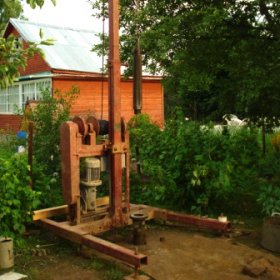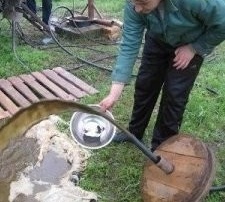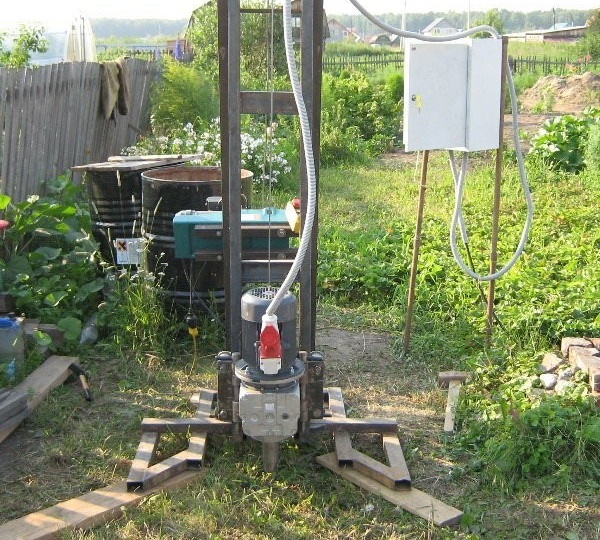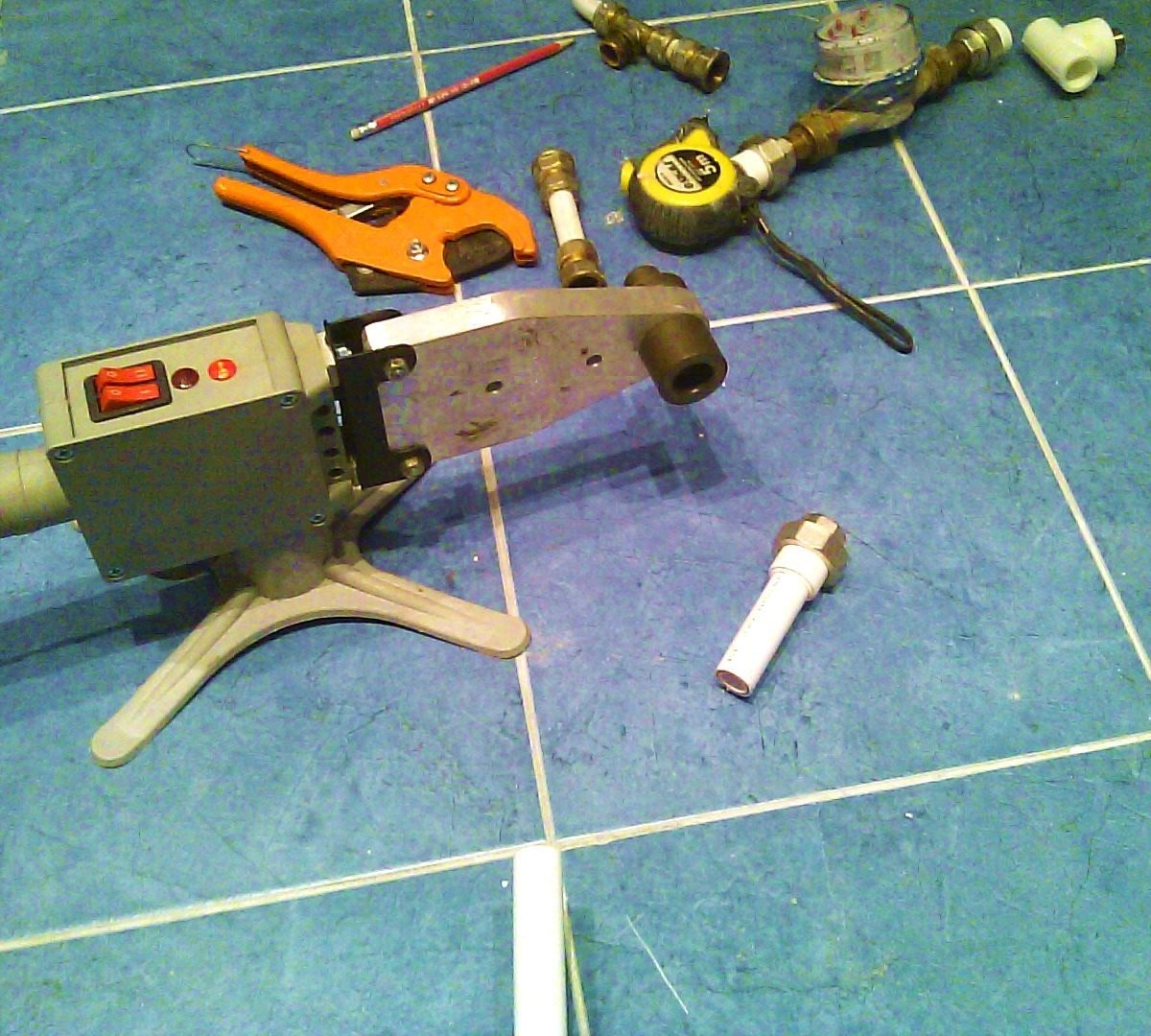How to make a well in the country: the order of drilling a well “on sand” + analysis of popular errors

A well-maintained well in the country is almost a prerequisite for a comfortable stay, because a centralized water supply system outside the city is far from always organized. However, drilling is expensive, and the expected result for the owners of the site is not guaranteed. The desire to save money and manage the process encourages many summer residents to do well drilling on their own. To complete this task is difficult, but quite possible.
Content
Is the water deep in your area?
To begin with, you should determine the type of well, finding out how deep the aquifer lies in a particular area. There are several possibilities for this:
- hydrological maps;
- exploratory drilling;
- poll of neighbors.
The first, as well as the advice of a hydrological engineer, can be obtained from relevant departments. Exploratory drilling is only used as a last resort, because it is expensive. Most often, the owners of the site simply ask their neighbors, who are already happy owners of an existing water well or well, about the characteristics of the object.
Read more on this issue in the article: How to find water for a well - an overview of 5 search methods + biolocation method in detail.
A bit about the types of water wells
According to the results of assessing the depth of the aquifer, the owners of the cottage will have to choose from three options:
- the water lies close, at a depth of 12 meters - abyssinian well;
- aquifer no deeper than 50 meters - well "on the sand";
- the water is very deep, up to 200 meters - the limestone well.
Near-surface aquifer bedding is rare. The happy owners of such a site can make an igloo well, the creation of which will take only one day or even several hours. The technology for creating the Abyssinian well consists in piercing the soil with a rather thin pipe: only 1-1.5 inches. At the end of the pipe, a conical filter, which facilitates penetration through the thickness of the soil. A suction pump is mounted on top. However, there is little water coming from the Abyssinian well, so construction of another source of this type of water may be necessary. The compact forms of the Abyssinian well allow you to drill such a well even in the basement of the house.
The “limestone” well, that is, an artesian well, is also not common. This option is good in that it allows you to get a large amount of very clean water.But it is almost impossible to drill such a well on our own, you will need to attract a team with professional drilling equipment. In addition, artesian water sources must be licensed by the appropriate authorities. Please note that if a layer of artesian water lies beneath the summer cottage, it makes sense to discuss joint payment of brigade services with neighbors, since such a well can easily provide water consumption for several households at the same time.

To create an Abyssinian well, a thin one and a half inch pipe with a filter tip is driven into the ground. The compact size and simple technology make it possible to build such a well in the basement of the house or to make an additional source of water at the cottage
Most often, water lies on the horizon within a fifty-meter depth. Such a well can be performed even by novice drillers using one of the methods developed for such situations. Which ones? Read on.
Which drilling method to choose?
For such large-scale drilling operations, you will need a special installation that you can make yourself. The type of installation depends on the selected drilling method:
- shock-rope;
- auger;
- rotary.
To make a unit capable of creating a narrow well several tens of meters deep, in addition to conventional tools, you will need a drill, grinder and a welding machine. Inexperienced craftsmen are encouraged to acquire the skills to work with these complex devices. Although the creation of a home-made drilling installation will require a lot of time and effort, the device can be effectively used in the future, for example, when installing a pile foundation. Some craftsmen with such an installation began their own business of installing water wells in neighboring cottages.
Option # 1 - shock-rope installation
A working tool of this design is a rather heavy cartridge and a choke mounted on a cable. A cable with a load is suspended vertically on a special bed. The soil is broken with the help of a cartridge and taken out by the bailer until the depth of the pit reaches the aquifer. The weight of the cartridge must be at least 80 kg. Manually, such devices are now practically not used, operations are performed using a rotary motor, which raises and lowers the rope with the load.

To create a shock-rope drilling rig, you will need a baffle and a cartridge with pointed edges, as well as a cable, a frame on which the load will be fixed, and a motor to control the cable
The lower edge of the cartridge is recommended to be sharpened, as well as to fix several sharp triangular elements on it to increase work efficiency. First, a hole of a suitable diameter is made in the ground with the help of a conventional garden drill, and then work begins with a chuck and a chipper. Shock-rope drilling is quite effective both on light and clay soils.
An interesting version of such an installation is presented in the video:
Option # 2 - auger drilling rig
During the operation of this device, the soil is removed using a special drill, which is made from a 100 mm steel pipe. A pair of turns of a screw with a diameter of about 200 mm are welded to its lower end. At the edges of the screw set two inclined steel knives. A removable handle, also made of a piece of steel pipe, is mounted on top.

To make a drill, several turns of metal with pointed edges are welded to a metal pipe. As the wellbore deepens, the pipe is extended to the required length
As the structure deepens into the ground, the main pipe is increased using a threaded connection or a sleeve. The device is fixed using a tripod tower made of wood or metal. To excavate a rather heavy pipe from a pit, it is recommended to use a winch with an electric motor.
Here is an example of auger drilling with simultaneous casing:
Option # 3 - rotary drilling rig
This is the most complex, but also the most reliable installation option for drilling wells. You can only make a frame for such a device yourself, and other elements, such as a drill rod, swivel, blade drill, motor pump and gear motor, are recommended to be purchased from a reliable manufacturer. With the help of such an installation, flushing drilling, percussion, rotary drilling, etc. can be carried out. The ability to supply a solution that erodes the soil and facilitates its excavation increases the speed of drilling operations several times.
Work example:
Please note that if one of the neighbors already has experience in self-drilling, it makes sense to ask about the opportunity to borrow ready-made drilling equipment.
The procedure for drilling a “sand” well
Like any important business, well drilling should begin with a draft design. First you need to choose a suitable location for the well. It should be located quite close to the house and as far as possible from sources of potential pollution: a septic tank, places of keeping livestock and poultry, a bathhouse, the shore of a reservoir, etc. It is necessary to take into account not only existing facilities, but also those that are still planned to be built on the site, since moving the well to a new location will be, to put it mildly, problematic.
When the plan is drawn up, it is time to begin its implementation. To do this, you must:
- Mark up for future work.
- Dig a pit for marking, which will include a tool for drilling (flap, screw, drill, etc.).
- Install drilling equipment.
- Drill in accordance with the selected technology.
- Lower the filter column into the pit, which is a structure of a filter, sedimentation tank and pipe.
- Fill the space between the outer walls of the casing and soil with sand or gravel.
- Seal the top of the pipe and pump water into it to flush the filter.
- Pump water out of the well using a baffle or screw pump.
- After the water has become clean, lower the submersible pump into the well with a safety cable.
- Connect a hose or water pipe to the pump.
- Install a valve on the pipe that controls the flow of water.
- Waterproof the protruding part of the casing above the surface.
- Equip the wellhead with a caisson and weld it to the tip.
- Lay the water pipes leading to the house in the trenches intended for them.
- Perform an external sprinkling of the caisson with soil and a concrete pavement.
This is a general procedure, depending on the conditions, necessary changes can be made.

A properly equipped caisson prevents wetting or freezing of well equipment. Industrial models of caissons made of durable plastic are very convenient to install
Overview of Popular Newbie Mistakes
As you know, the soil is heterogeneous and consists of different layers. To successfully draw a well through them, it is recommended to use various drilling methods:
- sandy horizons are best overcome with a drill spoon while flushing with drilling mud or plain water;
- for drilling hard sand, it is recommended to use a chisel;
- in quicksand use is considered the most effective bastards;
- for drilling clay it is better to use a coil, a bobbin or a drill spoon is also suitable;
- hard rocks are drilled in two stages: first, they are hollowed with a bit, then excavation is carried out;
- pebble and gravel formations also pass through the alternate use of a chisel and chipper;
- in most cases, the supply of water to the pit facilitates drilling and accelerates it.
It should be remembered that the dimensions of the pit should be slightly larger than the outer diameter of the casing. Choosing well pump it must also be taken into account that the minimum clearance between the inner wall of the pipe and the pump should be at least 5 mm, optimally 10 mm.
The fact that the drillers have reached the aquifer is indicated by the state of the soil. If wet soil appears from the well, then the water is close. Soon after, the drilling tool will go noticeably lighter than before when the drill enters the aquifer. Work should be continued until drilling is again difficult, that is, until a water-resistant layer is reached. Only then can drilling be stopped.

The submersible pump for the country well must be lowered to the correct depth. If the device is located too high, water will not flow in enough volume, and too low a position will lead to rapid siltation of sand
It happens that a recently drilled well suddenly ceases to function. This may indicate a poor quality of work. Both novices and professionals often make a number of mistakes while drilling. Here are the most common ones:
- Re-drilling, that is, drilling to an excessive depth, as a result of which the pipe “slipped” the aquifer. To remedy the situation, you should either raise the existing pipe to the desired level, or insert a new pipe of a smaller diameter inside the pipe, and remove the old one completely or partially.
- Incomplete landing of the casing in the pit, as a result of which the required debit of the well is not achieved. This is due to the soil collapsing into the barrel during the extraction of the drilling tool. The soil should be removed with a bailer (washing does not help) and sediment the pipe.
- A bit, i.e. the pipe is lowered to an insufficient depth. The well is drilled to the correct depth and a new filter is inserted inside the existing casing.
- The pump is lowered too low, as a result, the well is silted with sand. The pump is removed, the sand is selected by the chipper, the pump is installed correctly.
To install the submersible pump correctly, it must be lowered to the minimum depth. Then slowly immerse, checking the condition of the water every 20-50 cm. When the sand goes - the wrong position is reached, the pump must be raised to the level at which pure water came.


